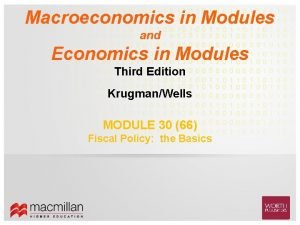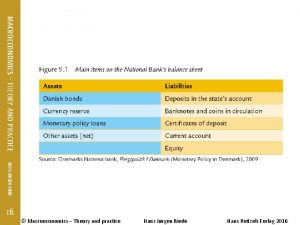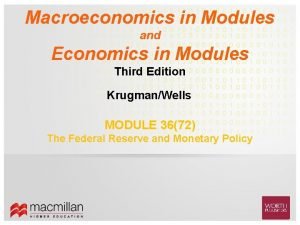Macroeconomics in Modules and Economics in Modules Third














- Slides: 14

Macroeconomics in Modules and Economics in Modules Third Edition Krugman/Wells MODULE 30 (66) Fiscal Policy: the Basics

What You Will Learn 1 Why fiscal policy is an important tool for managing economic fluctuations 2 Which policies constitute expansionary fiscal policy and which constitute contractionary fiscal policy 2

Government Spending and Tax Revenue for Some High-Income Countries in 2007 3

Taxes, Government Purchases of Goods and Services, Transfers, and Borrowing • Funds flow into the government in the form of taxes and government borrowing • Funds flow out of the government in the form or government purchases of goods and services and government transfers to households 4

Sources of Tax Revenue in the U. S. , 2007 5

Government Spending in the U. S. , 2008 Social insurance programs are government programs intended to protect families against economic hardship. 6

The Government Budget and Total Spending • Fiscal policy is the use of taxes, government transfers, or government purchases of goods and services to shift the aggregate demand curve. 7

Expansionary and Contractionary Fiscal Policy • Expansionary fiscal policy increases aggregate demand can take one of three forms: – an increase in government purchases of goods and services – a cut in taxes – an increase in government transfers • Contractionary fiscal policy reduces aggregate demand can take one of three forms: – a reduction in government purchases of goods and services – an increase in taxes – a reduction in government transfers 8

Expansionary and Contractionary Fiscal Policy Expansionary Fiscal Policy Can Close a Recessionary Gap Expansionary fiscal policy increases aggregate demand. Recessionary gap 9 9 of 17

Expansionary and Contractionary Fiscal Policy Can Eliminate an Inflationary Gap Contractionary fiscal policy reduces aggregate demand. Inflationary gap 10 10 of 17

Can Expansionary Fiscal Policy Actually Work? • There are three arguments against the use of expansionary fiscal policy: – Government spending always crowds out private spending – Government borrowing always crowds out private investment spending – Government budget deficits lead to reduced private spending 11

A Cautionary Note: Lags in Fiscal Policy • In the case of fiscal policy, there is an important reason for caution: there are significant lags in its use. – Realize the recessionary/inflationary gap by collecting and analyzing economic data takes time – Government develops a spending plan takes time – Implementation of the action plan (spending the money takes time) 12

Economics in Action What was in the Recovery Act? 13

Summary 1. Fiscal policy is the use of taxes, government transfers, or government purchases of goods and services to shift the aggregate demand curve. 2. Expansionary fiscal policy shifts the aggregate demand curve rightward. 3. Contractionary fiscal policy shifts the aggregate demand curve leftward. 4. There are three arguments against the use of expansionary fiscal policy: – Government spending always crowds out private spending – Government borrowing always crowds out private investment spending – Government budget deficits lead to reduced private spending 14
 Macroeconomics in modules
Macroeconomics in modules Branch of economics
Branch of economics Economics modules
Economics modules Mount hume classification
Mount hume classification Mount and hume classification
Mount and hume classification School of business and economics maastricht
School of business and economics maastricht Principles of economics oxford fajar pdf
Principles of economics oxford fajar pdf What is mathematical economics
What is mathematical economics Venn diagram macroeconomics vs. microeconomics
Venn diagram macroeconomics vs. microeconomics Venn diagram of macroeconomics and microeconomics
Venn diagram of macroeconomics and microeconomics New classical macroeconomics
New classical macroeconomics Ap macroeconomics supply and demand analysis
Ap macroeconomics supply and demand analysis Macroeconomics theory and practice
Macroeconomics theory and practice New classical and new keynesian macroeconomics
New classical and new keynesian macroeconomics Macroeconomics examples
Macroeconomics examples



























